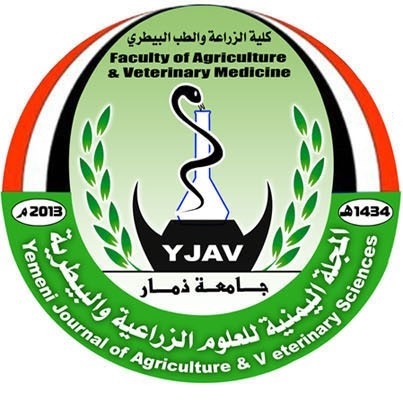Q. fever among staff workers and goats in slaughterhouses at Dhamar city, Yemen
DOI:
https://doi.org/10.70022/yjavs.v5i1.2037الكلمات المفتاحية:
Coxiella burnetii، Dhamar، Q. fever، slaughterhouses staff workers، Yemenالملخص
The study was conducted to determine the Coxiella burnetii antibodies among staff workers (Veterinarians &Butchers) and goats in slaughterhouses at Dhamar city. 250 blood samples were collected from staff workers and 263 samples from goats and tested. Staff worker’s sera samples were screened for IgG antibodies against C. burnetii phase I & II antigen by ImmunoDOT assay; while, in goat, by-Goat Anti-Q Fever ELIZA test. The results revealed that, out of 250 staff workers, 13(5.2%) showed the presence of antibodies against C. burnetti in their sera samples. The distribution of Seroprevalence rate of C. burnetii antibodies among the staff workers according to their demographic characteristics was as following: The higher rate was recorded (3.20 %) in age group of 31-40Yrs, 4.0% in workers had between 6 to 10 years of experience; 3.6% in Butchers and 1.20 % in March (spring season). The common symptoms in patients were flu-likes, fever, chest pain, endocarditis and hepatitis. The results of logistic regression confirmed the results of chi square analyses and revealed that there is a significant association between the seroprevalence of C. burnetii infection and the characteristics/risk factors of staff workers such occupation (OR=4.822; 95%CI: 1.363-17.064; P=0.015); symptoms (OR=1.820; CI: 1.345-2.463; P=0.000); whereas, no with Age, experience and seasons risk factors. In goats’ study, out of 263 sera samples tested, 23(8.57%) showed seropositivity for C. burnetii antibodies. The results of logistic regression showed that there is a significant association between the seroprevalence of C. burnetii antibodies and the characteristics/variables of goats such sex (OR=0.029; 95%CI: 0.007-.123; P=0.000); season (OR= 0.265; CI:0 .812-1.059; P=0.000), source of animal (OR=1.38; CI: 1.005-1.894; P=0.046) and ticks presence (OR=5.70; CI: 13.661-111.534; P=0.000): whereas, no with Age, breed and slaughterhouses localities factors. The results of Pearson`s correlation analysis revealed that strong association (r= 0.243; P= 0.000) between Seroprevalence of C. burnetii antibodies and relative humidity; while, no with temperature and rainfall (precipitation). In conclusion, seroprevalence of C. burnetii antibodies are prevalent among staff workers in slaughterhouses and goats at study areas. Research regarding spread of this pathogen within a country and its control is necessary.
التنزيلات
التنزيلات
منشور
كيفية الاقتباس
إصدار
القسم
الرخصة
الحقوق الفكرية (c) 2024 المـجلة اليمنية للعلوم الزراعية والبيطرية

هذا العمل مرخص بموجب Creative Commons Attribution-NonCommercial 4.0 International License.


